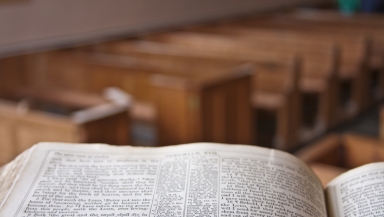
The Church of England first appointed female preachers during the First World War. This is the story ...
Women in the Church of England
The Church of England had effectively accepted the principle of women in leadership as early as the Tudor times, otherwise it could not have had Queen Elizabeth I, and later other Queens, as Supreme Governor of the Church of England.
The Great War
In 1866 the Church of England licensed men as lay readers, who were licensed to preach, but it was not then open to women. During the Great War, many women took up roles more traditionally taken by men. From the Church of England, huge numbers of men had gone to war, and many clergymen had also gone to serve as military chaplains.
Back home, women took on more roles in their local church. Traditionally men taught boys in Sunday School and women taught the girls, but now women were teaching the boys and the girls. In some places women started to read the Bible lesson, help with communion, and other tasks where a parish had no men left to do them.
The pragmatics of wartime meant that the Church of England decided to allow bishops to appoint women to help in ministry. These women were not ordained, but licensed as a new category of limited ministry under the discretion of each bishop. The first such women were appointed in London in 1916, when women were allowed to preach and lead services, although initially only to women and girls, during a National Week of Mission.
Bishop Gore of Oxford
The Bishop of Oxford, Charles Gore, was the most enthusiastic of the bishops for the idea of appointing women to new roles. In June 1917, he set up a committee to look into appointing women to help in ministry. This was tasked to prepare a scheme to supply the diocese with a band of women lay ministers. The Anglican Diocese of Oxford covers the largely rural English counties of Oxfordshire, Berkshire and Buckinghamshire. They looked into what training was needed, and how to recruit and appoint them. A lady called Mrs Illingsworth was appointed to liaise with clergy who wanted female staff to help them in the ministry.
The licensing service followed the official wording for appointing lay readers, who up to then were always male. The women were effectively lay readers, but were originally called the Diocesan Band of Bishop's Messengers. The Rev J.B. Seaton was appointed as chaplain and director of studies. Their secretaries were Mrs Brabant and Mrs Illingworth of Oxford. The first batch from the Diocese of Oxford were 21 women who were mainly wives and sisters of clergy, but not all.
Other Bishop's Messengers
Other Anglican bishops soon followed Bishop Gore's model. The Bishop of Southwell followed in appointing Bishop's Messengers, and the Bishop of Exeter started a similar scheme called the Women Evangelists. Eventually Women's Messengers were appointed by 21 bishops in England, which was about half of all the dioceses. Those appointed by the bishop could be invited by a clergyman to preach and lead missions. Often these were held outside on village greens and commons.
Diocesan Order of Women's Messengers
Although the scheme was set up as an expedient to meet the shortage of clergy during the war, it was so successful that it continued after the war. In 1919, the Diocesan Order of Women's Messengers was formally created as a national organisation and an Inter-Diocesan Conference of Women Messengers was held every two years. In 1926, there were about 400 Women's Messengers in England. In 1928, it was held in Oxford when there were 120 messengers.
Women's Messengers in Canada
In 1928, the Canadian Anglican Diocese of Rupert's Land in Manitoba also adopted the model. Women, starting with Miss Marguerita Douglas Fowler, were appointed as Bishop's Messengers to preach, spread the gospel, and establish schools and missions where there were not enough men to do it. She was later awarded an OBE for her work. The Bishop's Messengers of St. Faith's was later named The Order of St. Faith's and operated until 1979. The story is told in "The Story of St Faith's" by Marguerita Fowler.
Harbingers of Ordination
The last new ones to be appointed are believed to have been a group of six, appointed by the Bishop of Worcester in 1945. Later no more women were appointed, and the numbers slowly dropped as women left the order or died. It was not until 1969 that women were once again appointed as lay readers in the Church of England, when Rosamund Essex was appointed.
Miss Bangay
The longest serving of the Anglican Women's Messengers was Miss Bessie Bangay of Chesham. She was amongst the first group licensed by the Bishop of Oxford in 1917. Aged 28, she was appointed to help the vicar of the parish of Christ Church, Waterside in Chesham. She was tasked to run a village church called St George's in the small village of Tyler's Hill, near Chesham, where she ran the Sunday School.
She was quite pioneering for the time. In the 1920s, she started a women's cricket team and then in the 1930s, she started a new branch church meeting in a local pub in the nearby hamlet called Lye Green, which had no church. She also helped with evangelistic missions in Anglican parishes around Buckinghamshire upto 1945. Remarkably, she was the last of the Women's Messengers in England.
She continued to work into her 90s and died in 1987, aged 97. With seventy years of ministry, she holds the record for longest-serving woman in an official ministry position in the Anglican world. The story is told in the book "The Church by the Woods", published by Hawkes Design of Chesham.
The story of the Anglican Women's Messengers is little known, but they have been called the harbingers of the ordination of women in the Anglican world.













